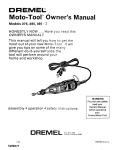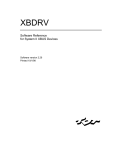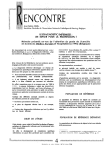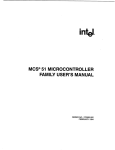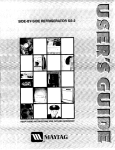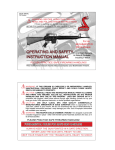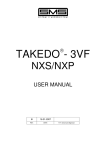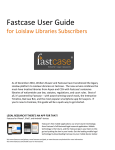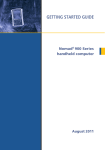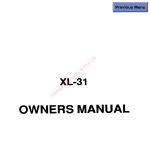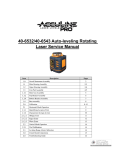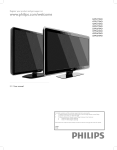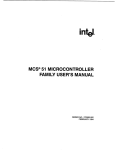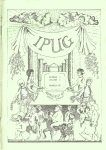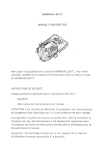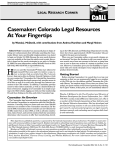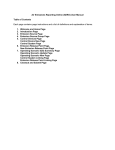Download Expert System Techniques for the Legal Research
Transcript
SmartLaw: Adapting “Clawic” Expert System Techniques for the Legal Research Domain Carole D. Hafher College of Canpu@r Scieace Norbastem University, Boston MA 02115 USA Virginia J. Wise Harvard Law school Cambridge MA 02138 USA Abtract ThiSreport describea research inprogreaaonthe development of ● computer expert system (SmartLaw) for giving advice on legal mead problems. Legal research exhibits many of the characteristics of a suitable domain for expert system developm@ however, it also poses unique challemgea for knowledge-based system design. To meet these challeng~, we use a four-level knowledge structure of reaeuch STIMTBGIES, GOALS, RESOURCBS and PLANS, with three processing componda: ● mbbaaed backwani+Aaining reasoning component, a Atabaae componemt, and a hypertext component. This paper explains our evolving model of legal reaeamh knowledge and deacribea the architecture d impi emmtation of a working pdotype of the Smartbw system. 1. Introduction As societb aod their legal system have lmmme mom complex, the pubkdon of legal iafbrmation has experkmced expIoaive growth. Publishers and consumers of legal information have turned to technology to assist them in managing this growth by offering fidl-text &tabawa and other computer-baaed systems. While such developmmta offbr many advantages to legal moamhem, theyareamixed bbaaillg. Reaewdm nownotozdy have to learn the conteut and arraagememt of the materkd, they also have todealwith avarietyofhardwm, Software, and communications optiona. In 1993, a researcher must Inasterbot hpriatan dektronicaources because not everything is available online. [Cheater 1991, Pritchard, 1988] There has also been a revolution of rising Permission to copy without fee that the copies are not made or ACM copyright notice and the notice is given that copying ,is Machinery. To copy otherwise, permission. @ 1993 ACM all or pan of dtis material is granted provided distributed for direct commercial advantage, the title of the publication and its date appear, and by permission of the Association for Computing or to republish, requires a fee and/or specific 0-89791-606-9/93/0006/0133 $1.50 133 expectations about both the quality, quantity and timeliness of information a researcher should be able to &liver, gives the existence of online resources. ~, 1989] Both law students and legaJ proftionala are increasingly iinding their research skills Ming behind these rising expectations. Many law schools, including the top American law schools, are now offering courses in Advanced Legal Research. 19861 Law firms are implementing their own ~ legal research training programs and mandating that summer clerks attend vendor training. But such courses, if done well, are extremely labor intensive and expmsive. Fmthermore, existing courses and textbooks in legal research (including computer-assisted instruction pro=h m Don Trautmau’s interactive videodkk ti ~ard 1990] and Paper Chase [Hardy 1990]) are orgauized bibliographically. Studenta learn about the various kinds of publications, what functions they perform, and how to use them., but this information is difficult to retain, since it is not learned in a problemSolving context. In this paper, we deecribe a reseamh effort to apply “classic” expert systems technology to addreas some of these difficukiea. We are developing an expert system (“SmartLaw”) which is intended to perform as a reference librarian or other consultant that a legal meamher may turn to for assistance. By organizing Smaluaw’s knowledge in terms of goals and strategies rather than legal bibliography, we hope to achieve a new and Useiid technique for helping lwxxlrchera which would aupplemeat existing instructional materials and offer several advantages: a. The advice cao be customized to fit a particular ~ tnsk, by skill level of the reseiucher, by jurisdiction and by topic. b. The system can be available 24 hours a day, seven days a week, where no humm aasistmw (such as a law a. Although the domain of law is very broad, the specific knowledge of legal publications, what they contain, and how to use them is quite specific and teclmical. b. Although the anmunt of knowledge is great for a complete legal research advisor, it can be broken down by jurisdiction, and to some exkmt by legal topic, and thus made manageable. @or example, there are legal topics such as tax law, labor law or haprtadon law for which most rwearch is conducted using specialized maoumea. Knowledge of these resources can be added to Smartlaw in a modular fashion.) c. Teachem of legal research and reference librarians are recognized experts in the domain, who currently offer advice to law students and others. d. Although general world knowledge is essential for actually doing legal reaewch, there is not much common seam involved in knowing how to use a digest or a citator, or knowing how to look up the text of a Cmgmssional committee hearing. (The system must have so= primitive knowledge of temporal relations, i.e. cakmdar dates). e. kw studeda definitely need this kind of advice (as reference librarians in law tirms and law schools can testify), and we hypothesize that they will not be rmistant to using a computer system if the advice offered by the system is useful. librarian) is available. This is significant since electronic media make it possible to do legal research outside of a library. c. It can provide help for those who are hedaut to ask a human expert for assistance for far of revealing their ignorance. d. It am provide Pointmf-use instruction so that lawyera who may have learned about a specific research tool, such as the Curre@ Index to Legal Periodicals, can be refreshed about the details of how to use that tool, warned about particular hamrds and common errora, or merely reminded that it exists. e. Itcanbe updated tomflect changes in legal research (This also applies tools mom eaaily than a textbook. to Computer-maisbd instruction programs.) f. It can integrate the use of online, plillt, and CD-ROM resourw by suggesting specific strategies which may be appropriate for each. In the next section, we present a brief discussion of why we believe legal rwearch is a god domain for a “classic” expert system. Section 3 gives ● detailed description of SmartLaw’s design and implementation, and Section 4 preaenta a sample dialogue. Section 5 discusses plans for filture work. 2. Whykgal reseamh isagooddomainfora “classic” expert system 3. system Design of Smartkw We can consider the characteristics of a problem domain which makeitagoodcaddate for a “classic” expert system. A “classic” expert system such as MYCIN @Aanan 19S4] acts as a consultant to a person who has a problem to solve. The system asks the user some questions in order to diagnose the problem and then offers advice. A classic expert system is intended tomimic theadvice and the reasoning of a human expert. Severai domain characteristics have been universally recognimd as import@ for a Successful expert system developwat projec~ [Prerau 1985]. a. The domain must be narrow, but mmplex enough to be worth creating a computer system for giving advice. b, The aawunt of knowledge required for effective performance must not be too great (several thousand ruh%butnottensof ~.) c. There must be recognimd human experta to provide the system’s knowledge. d. The role of geaeral world knowledge or cmnmon sense in solving this class of problems must be small. e. ’l%eremus tbeacategor yofuaers who need the system andwill bewilling to use it. explains our evolving model of legal This section research knowledge and deacribea the architecture of a Pm sy*m imple~ti using the Knowledge Pro development environment t E.nowldge Garden 1991]. Several d6x3ignrequiremeata were identified: i. The system should offer advice on research strategy, in addition to offering advice on which legal resources to consult and how to use them. ii. The sysem must be able to “scale up” to a large databaw of legal remuces, and be able to customize its advice to the current research topic and juris&ction. iii. Advice given to the user should be “how to” information addmwed to the current reeeamh need, rather than general expository information about the msoumes. However, more descriptive tutorial information should be easily accewed via hypertext, allowing users at varying levels of expertise to benefit. Requirement ii. rules out a purely rule-based expert system, since it is not feasible to represent unique rules for hundreds (or thmanda) of Xwourcw (including print and electronic publications) – even if it were Legal raearch appenra to match thaw criteria well: 1’34 possible towribsuch alargendebase, itwouldbetoo difficult to update. We require a nwre abstract approach, wheiu the specific mmurces caddbeeatered intoa dahbaae, aad the expert ayatem would embody general reasdlghedadca foraelecting n%oumes thm the databam. We also require that the advice of Smartlaw should depemdnot cadyonthenwoumes selected, but alsoonthe curnmtreaeamh goala, user~aticg and other elements of the reaeamh cmntext. m CITE ABBREV YAME AUTHOR KIND TOPIC JURIS START_YR STAL1;NIISS SUIT AUTH LEVEL R EF MEDIUM GOAL PLAN OTHER our answer to these challenging dsaign requirements wPin Figure l,which showathe architecture Of the Smartlaw system. The system consists of three major component a n,de-based reasdng component, a databaw mqonemt, and a hypertext component. First the rule-baaed mqmnemtselectaa strategy, definedin terms of the user’s maearch 00ALS. Next, a databaw of Resources isaeamhedtot%ld reaourwxl that satisfy the user’s goals. Once those rwoumes are found, PLANS fw using b remum%a are displayed as hypertext documeats. Figure 3.1 SmartLaw’s Rule-Based Inference System . . . . . . . . . . -------Strategies COALS y Resource Database PLANS Tutorial Information F Figure 1. Architecture of’ SnlartLaw 2. Smart Law Dattibase Schema Database of Legal Resources Each recQrd in the databwe represents a RESOURCE for achieving a 00AL for example, a court reporter satisfies the goal of looking up the full text of a case. Recxwds c.au-~resent a ~&lar remurce, such as the United States Code Semim, or a generic resource, such as a “state legal encyclopedia”. The fields of the databam (as curnmtly implen.wnted) are shown in Figure 2. The nanw, citation,author and type of the resource are followed by the legal topic it covers (or “any topic”), and the jurisdiction, which can be US, State, Non-US, a particular state, or gemeric. The w of the “STATE” jurisdiction allows the system to recommend resoorces (or types of remumea, such as “a state encyclopedia”) which are useful for state law research, even if the state does not yet have a module in the knowledge base. The next fields indicate the time span covered by a resource. The Start Date field is particularly important for on-line maoumea, IMXly of which Oldy began in the 1980’s and do not have the same information as their print counterparts. Users must be warned about these limitations. The “Staleness” information indicates how quickly new information appears in the lwource. For example, if pocket parts are published every six months foranann@ded code, onanygiven &yitwouldbeat most six months W. Since staleness is represented in &ys, the value for six months would be 1S0. The next group of fields helps smartLaw determine more strategies to rwmnmend to the user. A strategy is repreaeated as a goal tree, where the leaves of the tree repreaeat discrete GOAL elements which match maoumes inthedatabmeo which remurcea, among those which can satisfy a goal, Srethebw$t olu%torewmmend. ‘l%efielda repreaealk a. the suitability of a maource for achieving the goal b. the authoritativeaeas of the resourw c. the level of expertise needed to use it d. ita usefuhwsa to locate other rdevant material. S-w applies a simple goal-reduction model to formulate what needs to be accomplished in solving a legal maearch problem. Figure 3 shows part of of a Smartbw goal tree. The top-level goal “Research the Problem”, is associated with three attributes: -the legal topic, -the jurisdiction, -the dominant source of legal authority for the current problem (e.g., case law, atatutea, or administrative law) The Medium field indicatm whether the rwource is published print, Lexia, Weadaw, CD-ROM, etc. Raources available in more than one medium have a YESvalue inthe Other field, andarelinkedby ID to information about the maource in other media. l%emoat impmtat databww fiekia,f orthepurpoaeof this discussion, are the GOAL and PLAN fielda. The goal repreaeata oneofadefined aetoflegalmtwwch goals that SmartLaw recognims. It is the task of the rule-based inference component to ideatitjf one or more research goals which the user should pursue. These goals areuaed toselect rewrda fromthe dathae,and these records in turn, are inwrporated in the advice offered to the user. A resource record is selected if it matches the GOAL, the jurisdiction, and the topic of the user’s reaeamh, as debmbed by the rule-based componeat. Our detailed nmdel of legal research goals is described in the next section. The top level goal has four sub-goals: a. attain general background on the legal topic, and sufficient knowledge of ita vocabulary to formulate search requeata b. identify the relevant legal theories for resolving the current problem c. find controlling legal authority d. evaluate the status of the authorities found The firsttwo levels are common to almost all legal rwearch. At the next level, goal trees will differ &pending on the user’s problem situation. One strategy for idezki~ing the relevant legal theories and primary authority is the “periodical strategy”. This strategy is elaborated by using a periodical index, followed by looking up the periodical articles identified using the index, followed by looking up primary authorities meationed in the periodical articles. At the leaves of the tree are specific GOALS which can be used to retrieve msoumea from the database. While the GOAL field links the maource databawto the n.de-baaed infemmce S@f3111, the PLAN field links the rwource &tabaae to hypertext documents containing advi~ for the user. The value in the PLAN field identifies a hypertext block to be displayed (which in tum maybe linked to other hypertext bkwka.) One additional pointshould be noted about SmartLaw’s database: it is a hiddfm canpmumt of the system, km the user’s point of view. The user interacts with the rule-based componrmt thrcmgh menu selections and questionlanawer aeqlMlces. Theuaer alsointeractawith the hypertext CQqonent through viewing hypertext screens and folkwing hypertext links. However, the uaerdoea notinteract withthedatabwe wmponentof smartLaw. 3.2 SmaUaw’a ~Baaed In SmartLaw, jimction, Thej%nctwn authoritY and checking its current status. The FULL function represents a prt of the research process which we take for granted in our theoretical analysis, but which can pose problems for the less experienced researcher - even if the researcher has the citation of a relevant document, it is still nwesaary to know how to locate the fulltext inorderto readit. So, inreadinga law review article, the user may wme up with a citation toarulhgofthe Env”wcmmental protection Agency, and may deci& it is impmtant to read the text of the ruling. How does one look up such a ruling? Are they available p- Inferemce System “top SjWtt3Rl, has three wmponenta: componentof a !hnartbw goal is either BKG, FIND, UPDATE or FULL. The BKG function represmts the acquisition of background knowledge about a legal topic, FIND and UPDATE repreaeat the familiar cycle of locating level” of smartLaw is the rule-baaed inference i.QVCk8 the databe and hypertext Wmponrmta. The nbbaaed Wmponeat asks qw%tiona of theuaer inorderto find out theatage of theuser’s rwearch, thetopicdjwhdickn, thekindoflegal authorities which dombate the research topic, the user’s ~ to on-line maoumea, *“ Dqedillg oathe anawfxa totheae quaethathesyatem aelecta oneor ‘rile a GOAL object and given. which 136 4t tributes: I Legal Topic Jurisdiction Source of Authority Solve the Current Research I’roblem Update status of Authority ~~ Legal Theories I “ Periodictil Controlling Authority I Strateg}” Reid Articles to Obtain Information About Relevant Legdl Theories Use Periodical Index to Ob@in References to .4rticles I 4 Lrse footnotes in Periodical Articles to Obtain Citations of Controlling Authorities I * 1 M Wbe “given “part ot’ this goal will be CS, S1, RIM;, etc.if the user already bas the citfition of a case, statute, or regultition etc. to help in finding the relevant mtiterial (If so, SmarLaw may recummend using a full-text setircll instwci of ti periuclical index). Figure 3. A SmwtLaw on LEXIS? For moat law students, this would pose some difficulty. The object c.ornponeat of a Smarthw goal mpresenta the kind of authority that the user is seeking. For example, inunigmtion law is primarily atatutq, while contract law is primarily case baaed. Thus, the goal UPDATE_CS indicates that the current task is updating the status of cases which have beeQ located. If the jurisdiction is Massachusetts, this goal would retrieve database recordu fbr Shepud’s Massachusetts Citations. Ifseveral kindaoflaw 8reiqortant intheuaer’s reaeamh, goals will becreatad faeachofthem. The current choices are: case, statute, administrative, comtitutional, legislative history. Other kinds can be readily added if necamry. If the flUICtiOll componmt of a goal is BKG, thea the object component indicates what level of background the user requires. The given Componmt of a smartLaw goal describes the 137 Gotil Tree ir.dormation thatcanbeused asanentryinto the literatmx for example, a case citation, a statute citation, or subject terms to be used with an index. This allows SmaxtLaw to take advantage of the fact that users, even those having little or no background, often know the citation of some relevant authority which they have been told about by a teacher or senior colleague (e.g., ‘be sure to look at Smith v. Jones” or “you can start with Section 10b5 of the securities Act”). 3.3 %MWtblW’S Hypertext Advising system has beetl heated, slIMutLaw onceaaetofmaoumes displays their names inameam andallows theuaerto Whenarwource Select resowwa toleammomabout. is selected, the associated advice text is displayed. At thistime, theuaer canread theadvimforwi.ng the selected rwwurce to achieve the current goal. The advice text may include one or more hypertext links signified by “hot words” which are highlighted. When a hot word is activated, a new window opens up with a described in Section 3.2 is not yet integrated into the advice system, thus the dialogue does not show muMStep recommmdatl ‘Ons. fbrther exphmation of the hot word. The use of hypertext allows SnwtLaw to display some tutorial information for thoaeusexa whowant it, while users who donotwantto betutored atapardcuk timecan atillmakeuseofthe system as a problem solving aid. . Figure 4 is a “Welcome Screen” that gives the user a choice of advice on “finding the law” vs. looking up the full text of a known document. The procesaw involved in tbme two tasks (and the dialogue following the toplevel screen) is sufficiently different to be treated as two “components” of Smart.Law. (lWearchers working on general “library expert systems” have found the same division useful, e.g. ~arrot 1986]). Another knowledge-based legal rwearch system that combines hypertext with rules is the Datalex Workstation [Greenhf 1991]. However, unlike SmartLaw, Datalex repmsenta substantive knowledge of a narrow legal domain (the Autmlian Privacy Act). Its hypertext component is used to link sections of the Act toeachother, andtothemmqmdmg “ ndeaofa substantive legal expert system . Hyprtext has also been applied dinmtly to electronic treatises without the use of expert system techniques. 3.4. Further Figure 5 shows SmartIAw acquiring general information about the maearch problem: the legal topic, the jurisdiction, ad the media to which the user has access. Figure 6 shows the acquisiting of information about the currmt state of the useds knowledge. The last question the given component of the iuthisfigure wiudetemme‘ infixred maearch goal. Figure 7 shows !hmutbw’s rrmmmmdatl “On5. l%e!irst line %orderto ...” provides a pamphae of the current goal. When the user selects a reaoume which exists in several media, such as another menu apwars In&x to Legal Periodicals, informing the user of that fact, and asking which media the user wanta to see advice for. Figure 8 shows the initial hypertext display for Index to Legal Periodicals at the top, with the lower frame showing the expansion of the hypertext term ExampAe. Ex@oratb above, SmartLaw’s inferencemnponent selects one or more goals representing what the user shmdddon extinhisorher research. For each goal, rwounx% am retrieved from the databme, and displayed inameml. The Uaerumaele!ct onemaource atatime, and view the associated hypertext advica block which explains howtouae the maource to achieve the current goal. On exiting from the hypertext module, the ~ menu is repmted until the user selects “Proceed” - thus, information about one or nwre of the recommended resomes can bediaplayed andmpeated asrnany times Sstheuserdeaira. As mentioned 3.5. 5. Rwarch currently, our rearamh is aimed at using SmartL.aw experimentally with students in the Advanced Legal March class. The knowledge encoded in SmartLaw will be coordinate with student assigmnents, and we can observe the student’s use and acceptance of SmsrtLaw. Questions about the potential of SmartLaw as a useful educational tool inclwk Im phMmMklofsmartLaw prototype of sxnartLaw has been created, using An initial the KnowledgePro DOS devrdopnmmt system (a product of Knowledge Chrden, Inc.). KnowledgePro is a highlevel language that supports both rule-based and calvcaltional Pro-g (w’i~ backwad -g) prog ramming in an integrated system. KnowledgePro also has built-in hypertext capabdities which are a. Naturally a computer can never compare with a reference librarian, Who applies common sense, legal expertise, and the ability to interpret non-verbal cues (such asapuzzled lookwhtmthe stndentdoesnot undemtd the advi~ thnt has been offered). However, we have assumed that the computer can perform some of the functions of the reference libarian in transmitting to users. It rmnains to be seen important idOMMtiCMl whether, without cxnnmon aenae and human communication skills, the advice that is offered will be “on point”. CUIX@*Y pmple, ~ ~ io@f=o to Dcompatible ddabaae files. A new implermmtation is under developnmmt using KnowledgePro for Windows. Veraion 0,1 of SmartLaw, the first prototype, includes about 120 legal resources, and 20 inference rules. A sample interaction with this prototype is shown in the next section. 4. sample Plans and Questions Dialogue Figures 4 through 8 show a sample dialogue with the first prototype of SmartLaw. The “strategy” component b. Will atudeata have the patieace to work with a 138 computer,answering questiom from menus, *? Also, while offering an attractive, will that hct that Smarthw, mouse activated intdice, does not include “Sexy” animation, keep atude@! away? 7. Reflmml!ea Buchanan, B. G.; Shortliffe, expert systems: d. Is it practical to keep ● system like SmartLaw aufficiedy up to date, given the rapid rate of change of legal material? (See Section 1) Our plaos for future expansion of SmartLaw will take advantage of its modular Wucture toaddbothnew jurisdictions 8nd new subjects. Other imporhmt dmcementa aretheability ofuaerato request printed summaries of the xhice they have received, and the ability tolinkeaaily tocm-linereseamh aervicato retrieve till text of the rmoumes identified during a SmartLaw umaultation. We also are idematd in “ “ SmartLaw for use exploring possibilities fm cuatmmmg in different aettinga - for exanqde, allowing librariam to add local call numbers to document descriptions. Harvard Law School, Introduction Survey of Bmic to Legal Research: A Techniques, Refenence Services Qumerly 6 (3-4): FIND FULL - finding locating citation, for I#ormation would you !---;; --->1 pressman, S:, 1986. The 24-ho&-a4ay” lawyer. Ckl#ornia Lawyer 9(10): 61. Pritchad, T., 1988. Attorneys in the electronic information agq Is there a duty to make the Bar Journal 62(3): 17-20. transition? Flori& legal Hafner Figure like research and V. consultant Wise) 4. Sample to do next? ;;------1 FULL Tutorial Quit ! l-------------[ Management 3(3): Prerau, D.S, 1985. Selecti6n of an application domain 26-30. fbr an expert system. AZ J4agm”ne (Summer): the law relevant to your research problem full text of a particular document whose name or author you already know. What 123-139. 155-171. ! You should use this system if you have a research problem and would like advice on finding or accessing the relevant law. The expert system will ask you some questions about your problem, and then offer its recommendations. If your problem is outside the system’ ‘ s expertise, it will advise you to seek advice from a human expert. SmartLaw can offer two kinds of advice: --- 1990. Knowledge Gardea, Inc., 1991. Knowledge Pro Windows User Manual. Knowledge Garden, Inc., Setauket NY. Parrott, J.R., 1986. Expert systems for reference work, Microcomputer expert 1992, C. Research S.B., 1986. Advanced legal research courses: A new trend in American legal education. Legal This~ia aup@edby agrantfrom the National Center for Automated Information Retrieval (NCAIR). We would like to acknowledge the uaetid discussions of Terry Martin, Pmfkaaor of Law and Law Librarian, Hamard Univezaity, Frederick Schauer, Fraak Stanton Professor of the First Ammdment, Kamedy School of Govermnm t, HaIvard university, Donald H. Berman, University, Richardson Pmfeaaor of tiw, Nmbaatem andtheatubts inthe~onal Methodaia Legal Research cuureeo@red atthe HmwutiLawSchool. the ~the Project. KautTmm, 6. Acknowkdgemesta SmartLaw (Copyright Progranuning MA c. Arethequmtiona aakedby SmartLaw meaningfulto usera, anduethe ca@go&aofuaerneeds (represented by GOALA) an eflkctive way to atmctum advice? to experience Reading, Addison-Wesley. -, s., 1991. Electronic malpractice: Does masomdde competenw require cxxnputer ~h? JAw Practice Management 17(8): 22-27. Greeakf, G, A. Mowbray and A. Tyree, ‘The Datalex Legal Workstation - Integrating tools for lawyers. ” In Proc. 3nf Iid. Cod on Artt~cial Intelligence and Luw, Oxford, UK, June 1991 (ACM Press, New York), 215-224. Hardy, I. T., 1990. Project CLEAR’S paper choice: hypertext system for giving advice about legal research. Lzw Libra?y Journal 82(2): 209-237. Sta@ord Heuristic Welcome E. H., 1984. Rule based- the MYCIN / I Dialogue with SmartLaw If your research is in one of the specialized Otherwise, below, please select that topic. to get advice that is applicable to all legal l----------------------l Any topic I Government I Immigration I Tax Law l----------------------l --->1 What kinds of Select one or for (or “All” jurisdiction does your research fall this . research? --->1 under? I ------------- I i us I State . . . I Non-US I don’t know 1-------------1 I I states listed advice on Figure for . . 1------------1 All I Print I LEXIS I WESTLAW 1------------1 --->1 Please choose one of the to get general “Any state” I I I Benefits Law resources are available to you more answers in the list below Print, LEXIS, and WESTLAW) --->[ What topics listed select “Any topic” research. below, or select state law research. 1------------1 I Any state MA I NY 1------------1 S. Sample I Dialogue (cont.) Most legal research proceeds through several stages: a. I,cquiring general background knowledge about a legal topic about which :~ou have very little knowledge (Ex: Immigration Law) . b. Acquiring more focused background about particular legal issues t}at are relevant to your problem. c, Locating and reading the primary authorities relevant to your problem. d. Updating the current status of one of more primary authorities which you already have. Which of these objectives would you like to concentrate on right now? ---> What kind(s) of problem. Select law are one or most more important answers . l---------------------l I General Background I Focused Background I Find Authority I Update Authority I don’t know l---------------------l to your . . areas or is of law relevant the law on your l---------------------l case I statute I regulation I constitution I legislative I don’t know l--------------------- --->1 Figure to your research undergoing topic fairly stable? 1---------------1 I Rapid change I Fairly stable don’t know l---__________l_l 6. Sample Dialogue 140 I research --->1 Are the change, I I I I I (cont.) rapid history I i In order to get more background I recommend that you consult Choose an item from the menu you can best make use of it. continue with the consultation. in an area you know something about: the resources in the menu below. to learn where that item is found and how “Proceed” when you are ready to Choose l--------------------------------------------- I I -->/ Legal Resource Index Index to Legal Periodicals I Current Index to Legal Periodicals I Index to Periodical Articles Related I Proceed l--------------------------------------------- I to 1------------1 All I In Print I On WESTLAW 1------------1 I ! The Index to Legal Periodicals which you have asked about is available please select one or more of the following: (or “All” to see all recommendations) -->1 Law in several forms. I I The Index to Legal Periodicals is an axaaple of a legal periodical in&x produced by the E.W. Wilson Co. To find citations to articles in English language journals from the U.S., Great Britain, Canada and Australia which are at least 3-5 pages long, consult the subject index under your topic. You will be given a reference to the title, author and citation of a legal periodical. To see an example of a typical Index to Legal Periodicals entry, choose Example. The subject headings used in the Index to Legal Periodicals can be located by using the Index to Legal Periodicals Thesaurus. _________________________________________________________________________ Hypertext for Example Tax credits Developing computer technology with R.W. McGee. 31 Prac. Law 13-24 Je the ‘ 85 research credit. Tax credits (Subject heading assigned by H.W. Wilson). Developing computer technology with the research credit. of article) . R.W. McGee (author), 31 (volume number) Wilson to periodical Law. (abbreviation assigned by H.W. title, here Practical Lawyer) 13-24 (inclusive-pagination, article begins on page 13-and goes to page 24) Je ’85 issue, here June, 1985) . (Title Prac. (date e.g. of ________________________________________________________________________ I Figure 8. Sample Dialogue 141 (cent)









